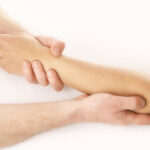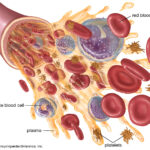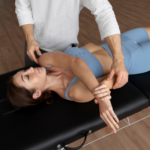One of the most common injuries experienced by athletes is the sprained ankle. According to the British Journal of Sports Medicine [1], about 40% of all ankle sprain injuries that occur are sports-related. A large portion of those injured individuals will develop chronic ankle instability which results in persistent pain, swelling, or recurrent sprains for at least 12 months after the initial sprain.
What is a sprain?
An ankle sprain is a musculoskeletal injury that occurs when the ankle is rolled, twisted or turned in an awkward way. Landing unbalanced from a jump, planting the foot awkwardly when running, or even simply walking on an uneven surface can be the cause of the injury.
![[A]](https://images.squarespace-cdn.com/content/v1/568c1797df40f37b331c4d04/1543498791345-LWFCTUZ7RL3XV0KAH144/sprained_ankle_ligaments.png)
[A]
The ankle joint, known as the talocrural joint, is made of three bones: tibia, fibula, and talus. Ankle joints are stabilized by ligaments that attach from bone to bone, passively limiting the range of motion at each joint. If the ankle moves in an unnatural way, the ligaments are forced to stretch beyond their normal range of motion, thus overstretching and/or creating a tear. The lateral ligaments of the ankle—anterior talofibular ligament (ATFL), calcaneofibular ligament (CFL) and posterior talofibular ligaments—tend to be the most commonly injured in sprained ankles.
Grades of Sprains
![[B]](https://images.squarespace-cdn.com/content/v1/568c1797df40f37b331c4d04/1543499152749-KQBEG7ZJMQKQDX808B9Y/Screen+Shot+2018-11-29+at+8.45.01+AM.png)
[B]
Grade 1 (Mild): slight stretching and micro-tearing of the ligament fibers; there may be mild tenderness and swelling around the ankle.
Grade 2 (Moderate): partial tearing of the ligament; moderate tenderness and swelling around the ankle and if the ankle is moved in a certain way, there may be a looseness of the ankle joint.
Grade 3 (Severe): a complete tear of the ligament; significant tenderness and swelling; if the ankle joint is pulled or pushed into certain movements, substantial instability occurs.
Treatment of Ankle Sprains
Depending on the severity of the sprain, there are a number of phases in which the treatment/rehabilitation process will go through.
Phase 1: includes (active) resting, protecting the ankle and reducing swelling; this is the immediate action taken following the injury. (Active rest refers to refraining from doing the action that causes pain, such as any weight-bearing movement on the ankle.) Ice can be used in 20-minute increments to reduce pain and swelling, and compression via a bandage or walking boot may help reduce swelling.
Phase 2: focuses on restoring range of motion, strength and flexibility; mature scar formation takes about six weeks and during this time, it’s important to focus on remolding the scar tissue in order to restore full function ankle movement and prevent a poorly formed scar that could increase the chance of re-tearing in the future. Strengthening the calf, ankle and foot muscles during this phase will help with gradual weight-bearing activity.
Phase 3: includes maintenance exercises and gradual return to activities that do not involve turning or twisting on the ankle—as this phase progresses, activities that involve those movements will be tolerable.
Prevention
Some tips that can help prevent a sprained ankle (or recurring sprain):
· Proper warmup before physical activity
· Wearing shoes that fit well and are made for the specific sport or activity
· Maintain good muscle strength and flexibility
· Practice stability training, including balance exercises (see below)
· Be aware when walking or running on uneven surfaces
· Use ankle support on a previously injured ankle, if necessary
Simple Balance Exercises (see reference [4] for a video of these exercises):
1. Stand with feet together and bend right knee (bring foot behind) to a 90 degree angle, hold 30 seconds to 1 minute. Repeat on left side.
2. Same exercise as above but with eyes closed. This can help with proprioception—the awareness of one’s body in its environment—which can be affected after an injury.
3. With eyes open again and while holding yoga blocks in each hand, lift one foot off the ground and slowly bend at the waist to place one block on the floor. Return to upright position and bend again to place second block on the floor. Repeat while standing on opposite foot.
Though much of the research done regarding manual therapy and ankle sprain recovery does not have strong findings, some studies show that manual therapy such as massage may provide short-term benefits after an ankle sprain. In addition, some studies also show that exercise, specifically balance-focused exercises, may reduce the risk of a recurring sprain.
Sources (viewed 11/30/18):
[1] https://bjsm.bmj.com/content/52/15/956.long
[2] https://www.sportsmed.theclinics.com/article/S0278-5919(16)30027-8/fulltext
[3] https://orthoinfo.aaos.org/en/diseases–conditions/sprained-ankle/
[4] https://youtu.be/ptF4doYU444
[5] https://www.ncbi.nlm.nih.gov/pmc/articles/PMC3103112/
Image references (retrieved 11/30/18):
[A] https://physioworks.com.au/injuries-conditions-1/sprained-ankle
[B] https://www.mayoclinic.org/diseases-conditions/sprained-ankle/symptoms-causes/syc-20353225
This article/video is for educational purposes only; do not attempt without your physician’s clearance. If you are in pain or injured, see your physician.
Copyright © Vidal Sports LLC 2018







